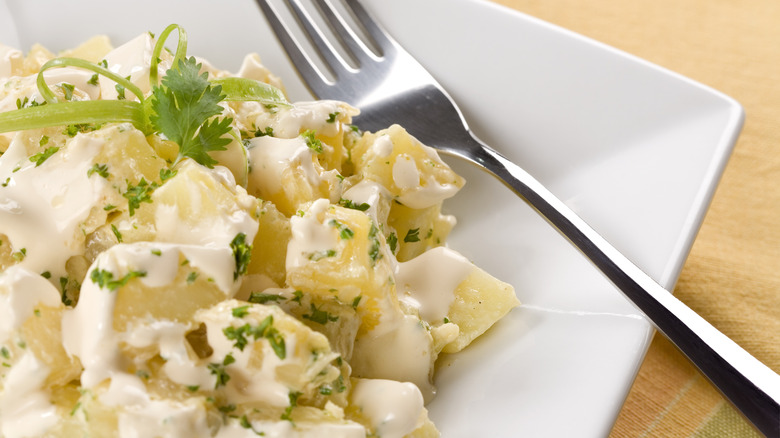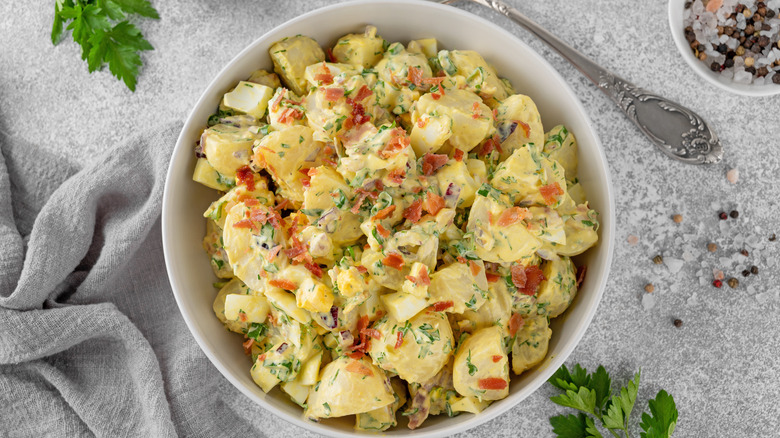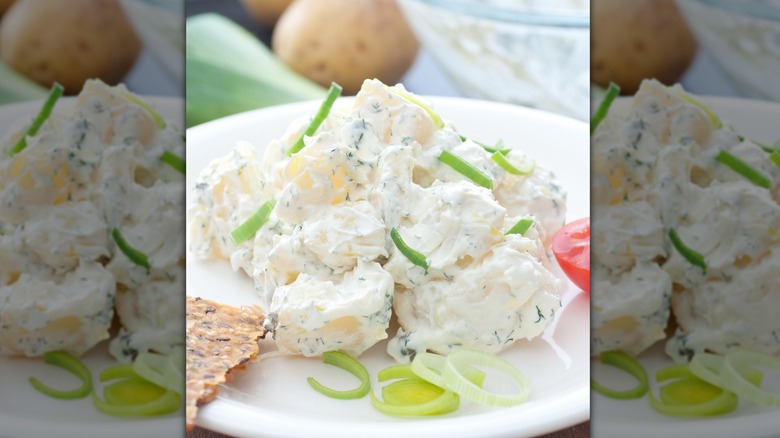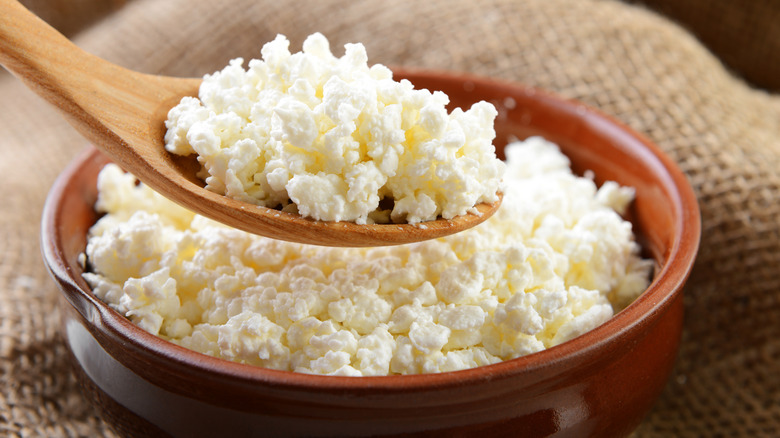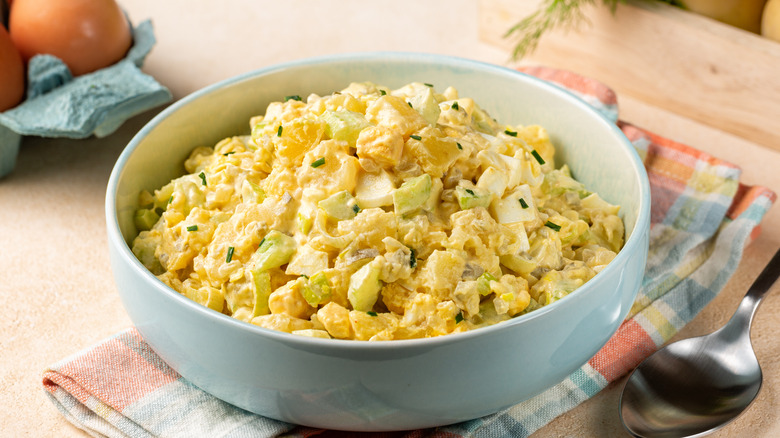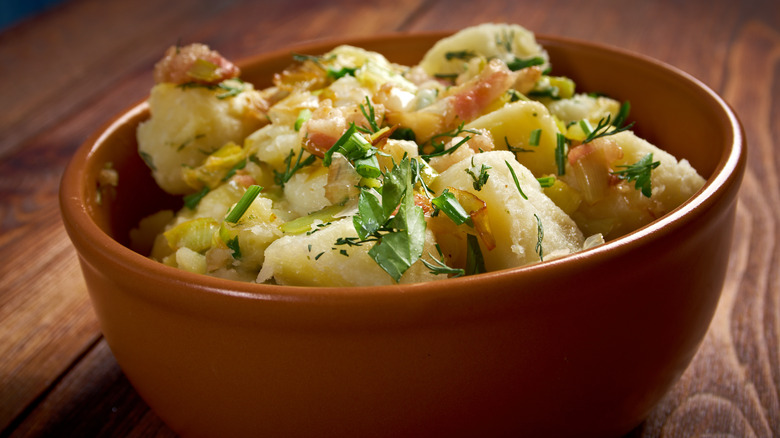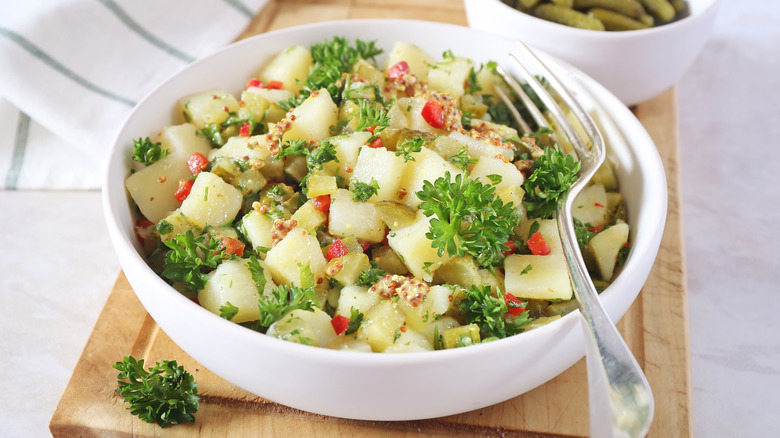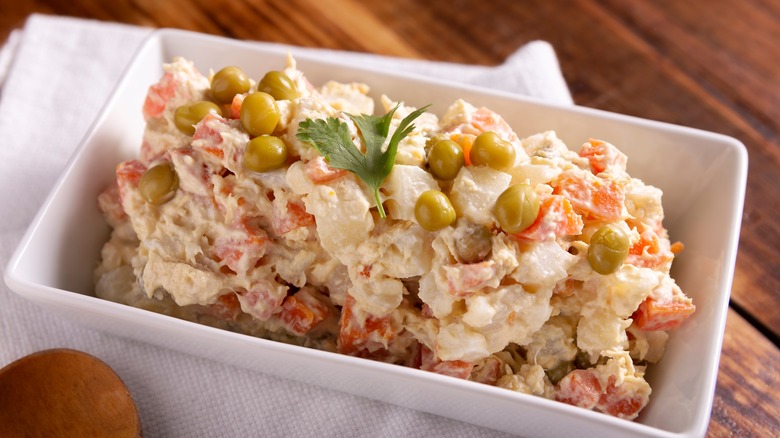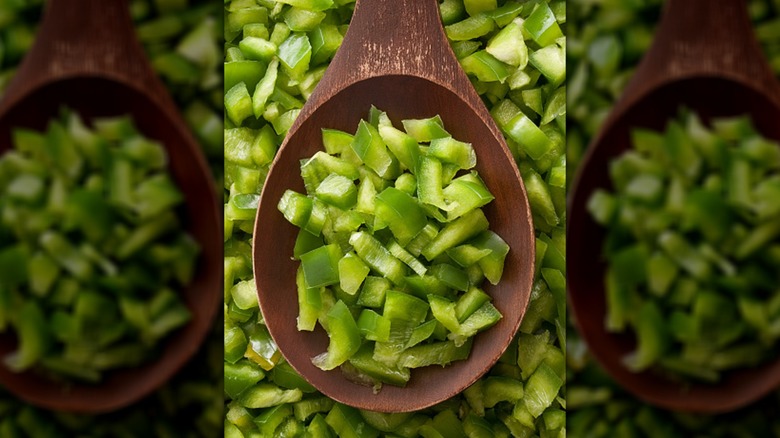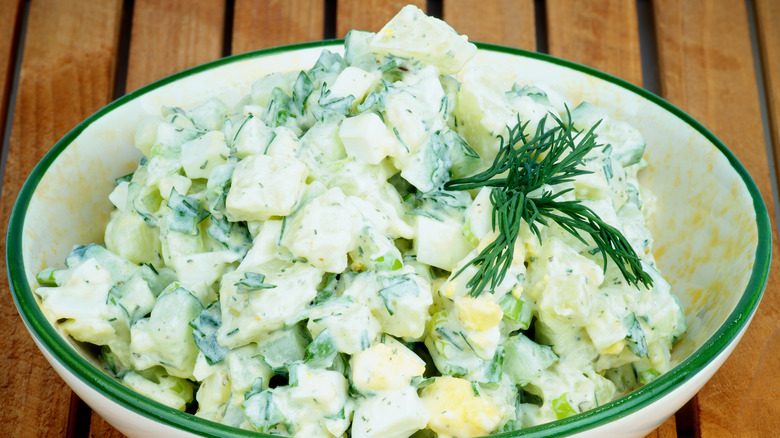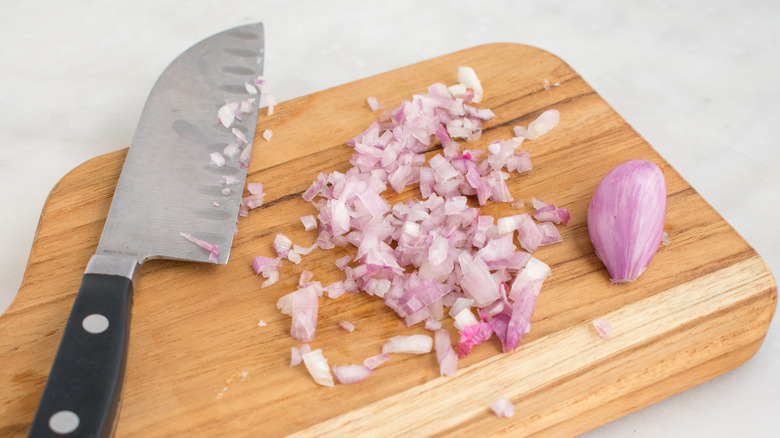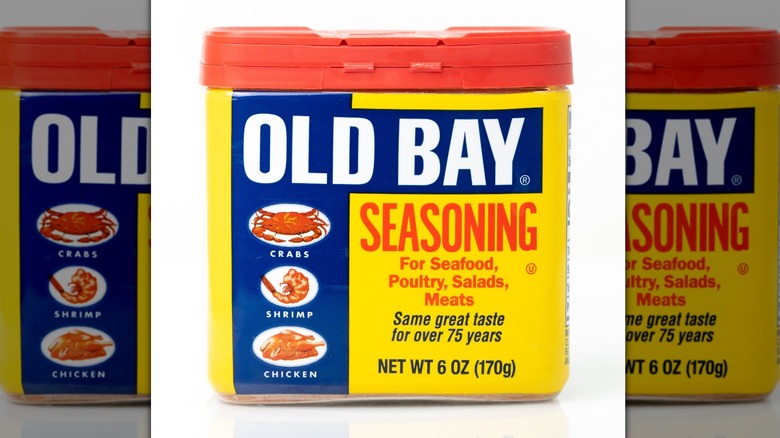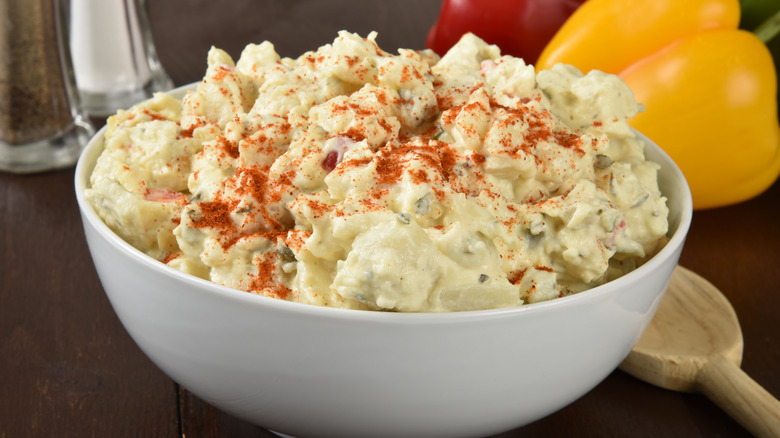11 Ingredient Swaps For Absurdly Good Potato Salad
A good potato salad has something crunchy, something oniony, and enough creaminess to balance the flavors. Potatoes are the starchy base but it's often the added ingredients that give different versions of potato salad their flavor and crunch. If you are short an ingredient or just want to try something new, there are plenty of variations on traditional potato salad that use substitutions or swaps. These subs are ones I routinely go for in restaurants or in my own kitchen at home. Some are brighter or lighter than heavy mayo-based potato salad and others enhance the already delicious flavors in potato salad. A few are so popular in certain areas that they've become their own local favorite or regional specialty.
Try one of these ingredient swaps to try a new spin on traditional potato salad, incorporate new spices and flavors, or use ingredients you have on hand as useful substitutes. Some change the flavor but others maintain the creamy potato salad taste while also providing different nutritional benefits. You can use these new ingredients together to make a new dressing for your potato salad, mixed in with a recipe that you already know, or as a one-to-one swap for a traditional potato salad ingredient.
Greek yogurt for mayo
This tangy substitution for mayo is thick and creamy without being as oily as mayo-based potato salad dressings. Greek yogurt has a similar texture to mayo so you can swap it one-for-one if you don't have mayo or just want to lighten up the dish. Make sure to use plain Greek yogurt instead of flavored to let the other tastes of the salad work with the dressing. Greek yogurt is thicker than regular yogurt, which may be too runny for a one-to-one swap. Plus, Greek yogurt has a brighter, tangy taste that works well in potato salad. You can also mix mayo and Greek yogurt to change up the flavor while still maintaining the richness of mayo-based potato salad.
Greek yogurt adds plenty of protein to the dish. Plain, low-fat Greek yogurt has just under 20 grams of protein in each 7-ounce container. Mayo, on the other hand, has around 2 grams of protein in the same amount. So swapping out similar amounts of mayo for Greek yogurt will boost the protein in your dish without changing the flavor or texture. They are also comparable in price. Greek yogurt is around $5.00 for a 32-ounce container while mayo is slightly cheaper at around $4.50 for a 30-ounce jar.
Sour cream for mayo
This substitution can be used in place of mayo. It isn't as strong of a tangy flavor as mayo but adding a bit of lemon juice can help balance it in potato salad. The texture is similar, however, so you can substitute one for the other without worrying about your dressing being too thick or thin. You can also swap out a portion of the mayo in your recipe for sour cream without seeing a noticeable difference in taste or texture.
One key difference between sour cream and mayo is the lack of eggs. Traditional mayo is made with eggs, making it unsafe for those who are allergic. You can find eggless mayo products, but sour cream is another excellent substitute. Sour cream also has much less fat; one cup of sour cream has around 46 grams of fat, while the same amount of mayo has 165 grams. It's important to choose the right sour cream for your potato salad. Regular sour cream is the silkiest but also has the most calories and fat, while light sour cream and fat-free sour cream are slightly lower in both. All work well as one-to-one substitutes for mayo but create slightly different variations of potato salad dressing.
Cottage cheese for mayo
Cottage cheese has a brighter taste than mayo, so it works well in potato salad if you want something a bit lighter. Keep in mind that the texture is different, so you may want to blend the cottage cheese up to make it smoother. You can use a food processor to make whipped cottage cheese, which is still light and airy thanks to the motion of the appliance. Cottage cheese can also be added to traditional mayo-based potato salad to make it lighter. If adding it to your dressing, fold it in as the last ingredient to help it maintain its creamy texture. Cottage cheese typically has a saltier taste than other dressing options so go light on your seasonings at first. Add salt and other seasonings to taste after folding in your cottage cheese.
Cottage cheese can be used to boost the protein content of a variety of salads, including potato salad, egg salad, and chicken salad. One cup of mayo has around two grams of protein, while one cup of cottage cheese has more than 24 grams. Cottage cheese is also significantly lower in fat, with just 5 grams in a single cup compared to 165 grams of fat in a cup of mayo. Not only does it taste lighter but the nutritional profile is much different as well, making this swap ideal for those looking to add protein to their diet or reduce their fat intake.
Dijon mustard for mayo
Swap out some of the mayo for mustard for an added kick in your potato salad. While it has the same consistency as mayo, using mustard as a one-for-one substitute for mayo will significantly change the flavor of your potato salad. Mayo and its substitutes are needed to get the signature, creamy taste that most people expect in potato salad, but if you want to make a more pungent side, it is possible to swap all of the mayo for mustard instead. Depending on your taste buds and personal preference, it's more likely you'll want to replace a quarter of the mayo for mustard and adjust each time you make potato salad until you find the right ratio.
You can use any kind of mustard but grainy dijon mustard works really well with the other flavors. It also incorporates easily with mayo, making a good dressing for the salad. Experiment with different mustards to find your own favorite. Some have more mustard seed powder or whole mustard seeds, which gives them more spice. Some have honey or other ingredients to bring out a sweeter taste.
Vinegar sauce for mayo
German potato salad has a vinegar base so it's not surprising that this makes a delicious substitute for heavier mayo. You can create a vinegar-based sauce or just swap out a bit of mayo for vinegar to add some great acidic bite to your dish. While not a staple in American-style potato salad, vinegar gets added in many variations around the world. Traditional German potato salad is served hot with vinegar, bacon, and other savory ingredients. While you can opt for the hot variety, vinegar also works with cold potato salad. Japanese potato salad often includes vinegar for flavor alongside creamier mayo dressing.
Vinegar doesn't make a good one-for-one substitute for mayo since it has a different flavor and consistency. You only need a little bit of vinegar for it to work with your dish and it won't thicken the potato salad like mayo does. Vinegar-based potato salads aren't creamy and mild like their mayo-based relatives. Instead, they have more of a pickled potato vibe without requiring the long wait time for actual pickled vegetables. Vinegar-based potato salads also work well with herbs like dill and spice from grainy mustard.
Cucumber for celery
Great potato salad has a little bit of crunch. This traditionally comes from celery because the flavor, albeit distinct, isn't overpowering. Instead it provides a garden freshness and texture to potato salad. Cucumber swapped in for celery works in a similar way. It has a slightly softer texture so make sure that the cucumber is fresh and firm, and chop the cucumber enough to mix in evenly with the rest of the ingredients.
You can use diced or sliced cucumber, depending on your preference and serving ideas. The key is to pick a cucumber that is sturdy. One example is the Kirby cucumber, which has a crunchy green skin that you can peel or leave on. These cucumbers are tougher, however, most often used for pickling. Another variety, the English cucumber, has a thinner skin that isn't as tough to chew.
You might consider peeling your cucumber as it is a bit easier to chew and blends better with the textures of the potato salad. Most of the veggie's nutrients are in the skin, so don't peel if you want that boost of fiber and beta carotene. In another variation of potato salad, you can add pickled cucumbers. These will impart both the snap and vinegar of a balanced dish.
Carrots for celery
Another crunchy substitute is carrots. You don't need to peel carrots but should rinse them well to remove any dirt or other residue. These work well when finely shredded using a julienne peeler. The finer you shred them, the easier they are to chew. Rough chopped carrots will be difficult and unexpected in a bite of potato salad so dice or shred them fine for the best texture. You might also need to cut them down so that you don't have long strips of carrot dangling from your fork as you try to enjoy your food. You can use baby carrots or whole carrots since you will be chopping them into smaller pieces either way. This style of potato salad is also known as Russian potato salad or Olivier salad.
You can add carrots to your potato salad for a boost of color and nutrients. Carrots have a lot of beta carotene, vitamin K, and potassium. Beta carotene converts into Vitamin A in your body, which is good for your eyes. Vitamin K helps your blood flow and clot properly while potassium is needed to conduct electrical impulses in the body. So adding carrots to your potato salad is not just good for your taste buds but also great for your body.
Green pepper for celery
Green peppers work well if you don't have celery or something else crunchy for your potato salad. Just be sure to dice them small enough to blend into the potato salad mixture. Green peppers have a higher water content than celery so you may need to adjust your dressing amount to prevent your potato salad from becoming watery. You can also add the green peppers just before serving to keep them crisp and crunchy rather than soggy. Green peppers have a lot of vitamins A, C, and E. Like other fresh vegetables, they also have plenty of fiber.
You can use other peppers but green peppers tend to have the mildest flavor. Make sure to use sweet peppers, such as green, red, or yellow, rather than hot peppers, like jalapenos, if you are substituting peppers for celery. Hot peppers add a lot of spicy flavor and not as much crunch. They make a flavorful addition but not a great substitute. For a celery sub, stick with the sweet peppers, finely diced.
Dill for relish
Relish is a popular addition to potato salad. But if you don't have any on hand, consider adding fresh dill instead. Fresh herbs work well in potato salad because they don't overpower the other flavors and mix in easily with the dressing. Traditional relish includes dill so it's not surprising that this herb fits right in with the other ingredients in potato salad. You can chop it up fine and mix it into the salad to distribute the flavor evenly. It also works well as a garnish when placed on top of the bowl right before serving.
Dill brings in a similar flavor but doesn't add moisture like relish does so you may need to add more dressing to get the consistency that you like. It's best to follow your recipe as-is, substituting dill for relish, and add extra mayo or mustard once you have it all mixed together. Dill works in place of dill relish or pickles but won't replicate sweet relish flavors. If you're used to sweet pickle relish, consider adding a splash of apple cider vinegar and some sugar instead.
Shallot for onion
If you don't have green onion, add shallots for the oniony flavor in potato salad. It has a milder flavor compared to other raw onions and you can mince it very finely. Shallots are considerably smaller than most onions so you might need two or even three to get the same amount that you would from an onion. You can also add fried shallots to a warm potato salad for a sweet, oniony flavor.
When adding shallots, start with a little bit and taste test your potato salad, adding small amounts of shallot as you go. If you want a stronger onion flavor, add more. It is hard to take finely diced shallots out once they are added so proceed slowly if working with this ingredient for the first time. Like onions, shallots are alliums. While they are milder than onions or garlic, shallots can quickly overpower other ingredients if you use too much and ruin the taste of your potato salad.
Old Bay for salt
This spice blend is popular in the mid-Atlantic states and makes a fun addition to potato salad. It works in place of salt but has an added sweetness and smokiness as well. Sprinkle Old Bay into the dressing in place of salt and mix thoroughly. You should try to get all pieces of your potato salad coated evenly rather than allows large chunks of the seasoning blend to sit in one place. You can also sprinkle Old Bay over the top of the potato salad for extra visual interest and a kick of flavor with the first few bites. Old Bay is so popular in some areas that it is served on the table at restaurants alongside the salt and pepper.
Old Bay is a blend with celery seed, salt, and mustard as well as other spices. While you can apply the Old Bay liberally, don't mix Old Bay and salt or your might end up with a super salty potato salad. Instead, substitute the Old Bay for the indicated amount of salt. Taste the potato salad after it is mixed and add more seasonings as needed. Keep in mind that the flavors will meld together even more as the potato salad rests in the fridge. You can always let it sit, taste again, and adjust before serving.
Methodology
Over the years, I've tried many of these swaps to see what worked in place of certain ingredients and what needed to be altered slightly to work with potato salad. I experimented with adding some ingredients, such as Greek yogurt and cottage cheese, to explore what potato salad was like with different tastes or nutritional benefits. Others became happy discoveries as they worked in place of ingredients that I just didn't have on hand, especially substituting different crunchy vegetables to take advantage of what was in season and in my fridge. Because the dressing in potato salad is so critical to the dish's taste and texture, I explored a lot of subs for mayo that would maintain the creaminess of potato salad but allow for variation in the ingredients list.
A few swaps were featured in restaurants or recipes that quickly became dishes I had to eat on repeat. Restaurants that rely on seasonal or local produce often get creative to take advantage of what is fresh and delicious each day. Substituting vegetables like carrots or cucumber was the perfect way to use the freshest ingredients in potato salad. I was happy to report on my favorites that created the perfect summer side dish.
